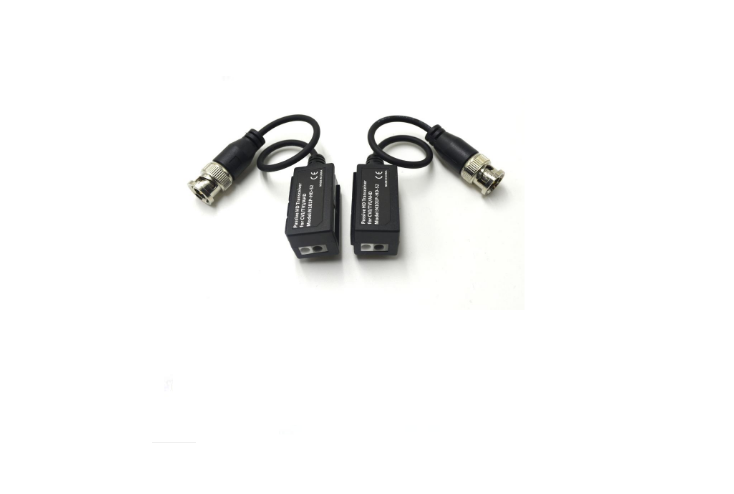CCTV Baluns: A Complete Guide
CCTV (closed-circuit television) systems often need to send analog video signals over long distances. A CCTV balun is a handy device that lets you use standard Ethernet cable (Cat5e/Cat6) instead of traditional coaxial cable for camera signals.

The term “balun” comes from “balanced-unbalanced”: baluns are devices that convert an unbalanced video signal (like from a BNC/coax) into a balanced signal that can travel over twisted-pair wire. In practice, baluns typically come in matched pairs (one at the camera end and one at the recorder/DVR end) to convert the signal before and after transmission.
How CCTV Baluns Work
A CCTV balun is essentially a signal transformer for video. Analog CCTV cameras output an unbalanced video signal on a coax cable (one signal conductor and a grounded shield). Ethernet cable uses balanced twisted pairs (equal and opposite currents).
The balun matches these: it “transforms unbalanced signals into balanced ones” so the camera’s video can ride along Cat5/Cat6 cable. For example, Triplett explains that a video balun “primarily converts an unbalanced video signal to a balanced one” and reduces noise on the line. This lets the video travel farther with less interference, making the cabling more flexible and cost-effective.
Key functions of a CCTV balun include:
- Converts signal format: Transforms the camera’s unbalanced video into a balanced signal on Cat5/Cat6, then back to unbalanced at the DVR.
- Works in pairs: You always use two baluns (a transmitter and receiver). One at the camera and one at the recorder complete the link.
- Extends range: Balanced transmission over twisted pair overcomes coax length limits, reducing signal loss on long runs.
- Optional power/audio: Some baluns can also send DC power or audio on the same cable, simplifying installations (see types below).
Why Use a CCTV Balun?
Baluns bring several practical benefits to CCTV installations, especially when running long cables or reusing existing wiring. Consider these advantages:
- Overcome distance limits: Analog CCTV over RG59 coax tends to lose quality past a few hundred feet. By balancing the signal, a balun lets you carry video much farther. One source notes that once coax signals degrade, “baluns become the solution”.
- Reduce interference: Unbalanced camera outputs can pick up hum and noise. A balun balances the line, so external noise is largely canceled out. This keeps the picture sharper on long runs.
- Cost-effective cabling: Cat5e/Cat6 cable is cheaper and more plentiful than RG59. Using baluns, you can often reuse existing network cable instead of pulling new coax. Triplett points out that if Cat5 is already in place, “a new coaxial cable is not needed”. This saves on cable and labor costs.
- Leverage existing infrastructure: Buildings often have spare Ethernet drops. Baluns let installers use those for cameras, avoiding extra drilling or long coax runs.
- Multi-camera support: A single Cat5 cable (with a multi-channel balun) can carry multiple cameras. For instance, one twisted-pair cable can transmit four analog signals (one per pair) if you use a 4-channel balun. This drastically cuts cable clutter in multi-camera setups.
- Versatility: Modern baluns handle various video formats (CVBS, AHD, HD-TVI, HD-CVI, etc.) and resolutions. They even work with hybrid systems mixing analog and IP cameras. This adaptability future-proofs the system.
- Easy installation: Baluns simply plug into a camera’s BNC output and an Ethernet port. No special tools (beyond standard RJ45 crimping) are needed, so setup is fast for DIYers and pros alike.
Types of CCTV Baluns
Baluns come in several varieties to suit different needs. The main categories include:
- Passive Video Balun – A basic, unpowered balun. It only converts the signal without amplification. Passive baluns are inexpensive and work well for short to medium runs (tens to a few hundred feet of Cat5). Use one at each end of the cable pair.
- Active (Powered) Balun – Contains electronics to boost or equalize the video signal. It requires power (often via PoE or an adapter) but can carry video much farther. Triplett notes active baluns can send video “hundreds of meters to over a kilometer”. Use active baluns for long distances or high-resolution cameras.
- Video+Power (PoE) Balun – Some baluns include a built-in power injector (PoE). A “video balun with power” sends the camera’s video and DC power together on one cable. This simplifies installations by eliminating a separate power run.
- Audio/Video Balun – Combines video and audio on one cable (and sometimes data). Useful for cameras with microphones or intercoms. Audio signals use an extra twisted pair, bundling video, audio, and power in one run.
- Multi-Channel Balun – Multiplexes several cameras onto one cable. For example, a 4-channel balun lets four cameras share a single Cat5 line, and a matching 4-ch receiver splits them back out. Great for installing multiple cameras with minimal cabling.
- Ground-Loop Isolating Balun – Includes circuitry to break ground loops and prevent hum. Ideal when cameras and the DVR are on separate power circuits and you see interference.
Coaxial vs Ethernet Cabling
Using baluns changes the cabling game. Here’s how traditional coax compares with twisted pair:
RG59 Coaxial:
75Ω impedance. Each camera needs its own run (plus power). Good for analog video up to ~300–500 feet; beyond that the image turns dark or greenish. Coax is thick and more expensive per foot.
Cat5e/Cat6 Ethernet:
100Ω balanced cable. Thinner, cheaper, and readily available. One Cat5 can carry multiple cameras with multi-channel baluns. It rejects noise better, and with baluns it can carry video even farther (passive or active boosts). Ethernet also natively supports data and PoE.
|
Feature |
RG59 Coaxial |
|
|
Impedance |
75Ω |
100Ω |
|
Connectors |
BNC (1 per cam) |
RJ45 (one cable can carry multiple cams) |
|
Cost |
Higher per foot |
Lower per foot |
|
Noise Immunity |
Moderate |
High (balanced pairs) |
|
Max Distance |
~300–500 ft (analog) |
~500–1000+ ft with active baluns |
|
Flexibility |
Fixed (1 cam per run) |
Multi-cam support via multi-channel baluns |
Use case:
If a building has existing Cat5 drops, simply plug each analog camera’s BNC into a balun and connect it to the network cable. These reuse wiring and avoid new trenching or cable.
Installation Tips
- Use good cable (Cat5e/Cat6, solid copper). Don’t untwist pairs more than necessary.
- Follow straight-through wiring on RJ45. Many video baluns use one specific pair (often pins 7-8). Check the balun’s instructions for pair assignments.
- To avoid ground loops, try an isolating balun if you see hum.
- Stick to one balun type per link (all passive or all active) to avoid mismatches.
- Verify format compatibility (CVBS vs HD). High-res analog needs high-bandwidth baluns labeled for those formats.
- If not using PoE, plan separate power lines to cameras (e.g., Siamese cable or DC wires).
Conclusion
In short, CCTV baluns bridge analog cameras to Ethernet cabling. By converting the camera’s unbalanced video into a balanced signal, they let you run video over Cat5/Cat6 – cutting costs and extending range. Using the right type of balun (passive, PoE-powered, etc.) lets you mix analog and IP/HD systems, reuse existing network cable, and avoid running expensive coax. As one guide notes, this approach “enhances the flexibility and scalability of surveillance systems.”
For example, a high-quality active balun can carry HD analog video hundreds of meters, far beyond what RG59 coax allows. In effect, a CCTV balun is a small gadget with a big impact: it extends cable runs, cuts down interference, and lets you use inexpensive Ethernet cable for your cameras. Whether you’re wiring a single home camera or dozens across a site, the right balun will make your surveillance system more reliable and cost-effective.











